One aspect of tropical rainforest biodiversity that makes it so exciting, at least for a biologist, is the possibility of happening upon rare species. Of course the ultimate prize is the discovery of a species of organism which is completely new to science. The very idea of laying eyes upon an organism that no other person has ever seen is enough to send any self-respecting biologist into paroxysms of delight. Of course there is a caveat, one must always acknowledge that the organism in question is likely well-known to the indigenous people who inhabit a given study area. Their eyes are phenomenally attuned to the natural world which surrounds them; quite expected since their survival often depends upon having an intimate knowledge of the flora and fauna of their territory. Be that as it may, as scientists, the role of making a new species known to the world of academia is a significant one. In many cases, particularly if the new find happens to be a vertebrate, this will lead to awareness of the new species by the general public as well.
Even now, well into the 21st Century, the tropical rainforests of the world are incompletely known from a biological standpoint. Granted it is now rare that we find a new mammal or bird. But, on the other hand, many less glamorous organisms such as bacteria, fungi, and even insects still await discovery (my apologies to bacteriologists, mycologists, and entomologists). As an example, a few years ago I met a group of middle school pupils who were taking part in a Jason Project excursion to northeastern Peru. Incredibly, during their field work, these students 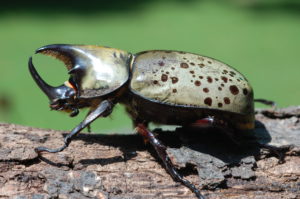 discovered a species of beetle that was previously unknown to science. Knowing whether or not one has a new species in hand requires expertise of course. Thus it is that one will find specialists in the taxonomy (identification and classification) of any particular group of organisms one wishes to choose. Some taxonomists go for the gold and tackle a group with charismatic star-power such as the dinosaurs. Others may, with forethought, choose a group of organisms in which taxonomic competition among biologists is less intense. Harvard entomology professor emeritus E.O. Wilson chose to become a myrmecologist (ant biologist) and in the process carved himself a niche within which he holds sway as the world’s acknowledged expert on this group. Some biologists will opt for an even more arcane group. This almost certainly guarantees them supremacy of expertise in their chosen area.
discovered a species of beetle that was previously unknown to science. Knowing whether or not one has a new species in hand requires expertise of course. Thus it is that one will find specialists in the taxonomy (identification and classification) of any particular group of organisms one wishes to choose. Some taxonomists go for the gold and tackle a group with charismatic star-power such as the dinosaurs. Others may, with forethought, choose a group of organisms in which taxonomic competition among biologists is less intense. Harvard entomology professor emeritus E.O. Wilson chose to become a myrmecologist (ant biologist) and in the process carved himself a niche within which he holds sway as the world’s acknowledged expert on this group. Some biologists will opt for an even more arcane group. This almost certainly guarantees them supremacy of expertise in their chosen area.  For example, when I was in graduate school, one of the professors in our department was an expert on the taxonomy of psocids. You may rightly ask, what in the world is a psocid? Many psocids look like tiny flies. Others, being wingless, resemble lice. Technically speaking, they belong to a group of insects known as booklice. They are quite small, one or two millimeters in length, and feed on lichens and fungi. Psocids often perch on shrubby vegetation. This particular professor could regularly be seen wandering about the campus with the tools of his trade – a black umbrella, a stout club, and an aspirator. Upon approaching a shrub, he would open the umbrella, hold it upside down under the vegetation, and suddenly begin flailing the branches with his club as though possessed by the sudden onset of some sort of mania. This frantic and, to outward appearance, bizarre routine would be met with open-mouthed astonishment by passersby. It really was quite entertaining to watch him at work. Of course, he was collecting psocids. Pummeling the shrubbery would cause any psocids present to fall onto the black umbrella. Here, despite their tiny size, the whitish body color would make them readily apparent. The aspirator was essentially a test tube with a stopper in it. From the stopper protruded two tubes. One was a short glass piece which the prof placed in his mouth. The other was a longer plastic tube which was positioned next to a psocid perched on the umbrella. A gentle suction applied to the glass tube resulted in the psocid being vacuumed into the test tube. A very interesting operation it was and one which made me admire the entertaining eccentricity of many scientists even more.
For example, when I was in graduate school, one of the professors in our department was an expert on the taxonomy of psocids. You may rightly ask, what in the world is a psocid? Many psocids look like tiny flies. Others, being wingless, resemble lice. Technically speaking, they belong to a group of insects known as booklice. They are quite small, one or two millimeters in length, and feed on lichens and fungi. Psocids often perch on shrubby vegetation. This particular professor could regularly be seen wandering about the campus with the tools of his trade – a black umbrella, a stout club, and an aspirator. Upon approaching a shrub, he would open the umbrella, hold it upside down under the vegetation, and suddenly begin flailing the branches with his club as though possessed by the sudden onset of some sort of mania. This frantic and, to outward appearance, bizarre routine would be met with open-mouthed astonishment by passersby. It really was quite entertaining to watch him at work. Of course, he was collecting psocids. Pummeling the shrubbery would cause any psocids present to fall onto the black umbrella. Here, despite their tiny size, the whitish body color would make them readily apparent. The aspirator was essentially a test tube with a stopper in it. From the stopper protruded two tubes. One was a short glass piece which the prof placed in his mouth. The other was a longer plastic tube which was positioned next to a psocid perched on the umbrella. A gentle suction applied to the glass tube resulted in the psocid being vacuumed into the test tube. A very interesting operation it was and one which made me admire the entertaining eccentricity of many scientists even more.
Obviously then, collecting and naming new species of living things is not a common occupation. Try to think of the last time you asked someone what they did for a living and they replied, “Actually, I’m a taxonomist.” This, in reality, is a problem. The International Union for the Conservation of Nature (IUCN) lists some 20 000 species as currently in danger of extinction. Given the speed at which natural areas of the world are being lost to development, there simply aren’t enough trained taxonomists to catalog all the organisms which are likely disappearing.
Incidentally, today’s rate of biodiversity loss of is so great that many scientists believe that we are now in the midst of our planet’s sixth mass extinction episode. Because this rate of loss is so high, and we have too few taxonomists, we may not know the potential value of species that are disappearing. In some cases this importance may be entirely a question of ethics. Many, me included, believe that the wild organisms of our world have a basic entitlement to pursue their continued existence absent the threat of annihilation by humans. In other cases, the survival of organisms may have direct benefits to humans as sources of medicine, foods, or fibers. As an example, we should remember that nearly one-third of our pharmaceuticals are plant derived. Might it not be possible, in our wholesale clearing of tropical rainforests for example, that we extirpate a plant species with extreme efficacy in treating cancer or an animal whose venom might serve as a highly effective, non-addictive analgesic? Such a loss could occur without awareness on our part that such a valuable organism even existed in the first place? (*Do a Google search for the rosy periwinkle to appreciate the life-changing power of a plant-based pharmaceutical.)
But, despite these reasons for unease, let us return to more positive musings. The modest company of biological taxonomists active today ply their skill as best they can. For biologists working in the tropics, even those who aren’t technically specialists in taxonomy, the possibility of discovering rarities is always lurking. Like hitting a biological lottery, the rare species may unexpectedly turn up and grant the investigator a prize of great worth. Such was my experience while working as a vertebrate zoology lecturer at the University of Agriculture (now Universiti Putra) in Malaysia.
My colleague Phoon and I were teaching a course for our secondary education students at the University of Malaya’s field station at Ulu Gombak.  The research station sat along the main trunk road which led from Kuala Lumpur, near the west coast, to the city of Kuantan lying hard by the South China Sea to the east. The facility was comprised of two buildings. One served as a laboratory where specimens collected during our forays into the rainforest could be identified, observed, and catalogued. The other building contained dormitories for the students, two small private rooms for staff, and a kitchen where the three meals students and staff took each day were prepared. In front of the dormitory, a small but well-manicured lawn sloped downward toward the nearby forest edge and the Sungei Gombak which flowed just inside the wall of trees. Although called a river, this stream was only a few yards across. I suppose a world-class long-jumper could have cleared it in a single leap. Nevertheless, the stream’s constant, muffled roar was a pleasant addition to the symphony of rainforest sounds falling steadily upon one’s ear. The stream was also a fruitful site should one want to search for caecilian larvae or foam-nesting tree frogs.
The research station sat along the main trunk road which led from Kuala Lumpur, near the west coast, to the city of Kuantan lying hard by the South China Sea to the east. The facility was comprised of two buildings. One served as a laboratory where specimens collected during our forays into the rainforest could be identified, observed, and catalogued. The other building contained dormitories for the students, two small private rooms for staff, and a kitchen where the three meals students and staff took each day were prepared. In front of the dormitory, a small but well-manicured lawn sloped downward toward the nearby forest edge and the Sungei Gombak which flowed just inside the wall of trees. Although called a river, this stream was only a few yards across. I suppose a world-class long-jumper could have cleared it in a single leap. Nevertheless, the stream’s constant, muffled roar was a pleasant addition to the symphony of rainforest sounds falling steadily upon one’s ear. The stream was also a fruitful site should one want to search for caecilian larvae or foam-nesting tree frogs.
Across the front of the dormitory building ran a long, covered veranda. Tables and chairs for dining were arranged the length of this large balcony which stood a dozen feet above the aforementioned lawn. The porch was a wonderful place to sit and enjoy delicious curries of rice, fish, or chicken in  company with the cheery Malay students. All the while we could gaze out onto the nearby mountains, their slopes cloaked with a thick covering of dipterocarp forest.
company with the cheery Malay students. All the while we could gaze out onto the nearby mountains, their slopes cloaked with a thick covering of dipterocarp forest. 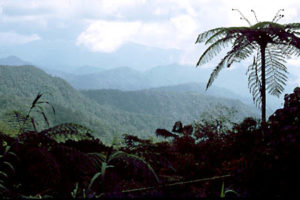 The superstars of this forest were the massive Shorea trees whose grayish- leaves caused them to stand out among the numberless greens of their brethren. Some of these Shorea were giants who towered over two-hundred feet above the forest floor. Occasionally a guttural call or a thrashing, leafy branch would alert us to the presence of a band of dusky or silvered leaf monkeys moving through the canopy. A flying lizard (Draco) might be seen soaring across the lawn its rapid, direct “flight” causing one to momentarily mistake it for a bird. On more than one occasion, the morning was embellished by a flyover of one of the rainforests largest birds, the rhinoceros hornbill. Occasionally the flight would be announced by the magnificent bird’s ringing, honking call. At other times the hornbill might pass above us without voice, its presence announced only by the deep, far-carrying sound from the beats of its five feet long wingspan.
The superstars of this forest were the massive Shorea trees whose grayish- leaves caused them to stand out among the numberless greens of their brethren. Some of these Shorea were giants who towered over two-hundred feet above the forest floor. Occasionally a guttural call or a thrashing, leafy branch would alert us to the presence of a band of dusky or silvered leaf monkeys moving through the canopy. A flying lizard (Draco) might be seen soaring across the lawn its rapid, direct “flight” causing one to momentarily mistake it for a bird. On more than one occasion, the morning was embellished by a flyover of one of the rainforests largest birds, the rhinoceros hornbill. Occasionally the flight would be announced by the magnificent bird’s ringing, honking call. At other times the hornbill might pass above us without voice, its presence announced only by the deep, far-carrying sound from the beats of its five feet long wingspan. 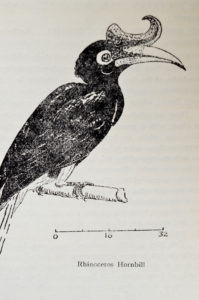 They reminded me of the chugging of a slow moving steam locomotive. Breakfasts were often graced by the exotic, high-pitched whooping of white-handed gibbons or the deep, booming voice of siamangs issuing from the far hills as they performed their morning routine of establishing territorial boundaries and maintaining the unity of their groups. Looking back I recall a magical place, a kind of Eden where I found myself joyous simply to be alive, euphoric over my good fortune in being present in one of planet earth’s last, great wild places.
They reminded me of the chugging of a slow moving steam locomotive. Breakfasts were often graced by the exotic, high-pitched whooping of white-handed gibbons or the deep, booming voice of siamangs issuing from the far hills as they performed their morning routine of establishing territorial boundaries and maintaining the unity of their groups. Looking back I recall a magical place, a kind of Eden where I found myself joyous simply to be alive, euphoric over my good fortune in being present in one of planet earth’s last, great wild places.
One afternoon, I was in the lab engaged in the identification of some of the insects the students had collected. My lab assistant, a chap by the name of Rajoo, came into the lab with a bat. He had found the bat, already dead, lying along the side of the road which ran nearby. The specimen was in prime condition. In the tropics this is a rare situation. A dead mammal quickly begins to decompose due to the high ambient temperature. They are also invariably set upon by ants which can destroy a carcass within minutes. Rajoo’s bat specimen must have met its demise very recently.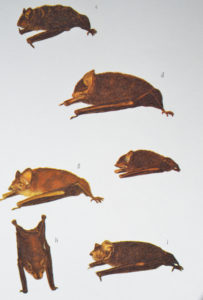
I didn’t recognize the bat’s species immediately although I did notice the odd structure of the nostrils. Instead of simple external openings to the nasal passages, these were like small cylinders with the nares at their ends. From this character, it was fairly obvious that the specimen belonged to a group known, logically enough, as the tube-nosed bats. I decided to go ahead and make a museum specimen of the bat. This simply involved removing the skin and placing it over an appropriately sized body made of cotton. The wings and legs were braced with small wires and then the specimen was left to dry. Such mounts, if protected from insect pests, can last for well over one-hundred years. The head was kept as well. The skull, cleaned of flesh by a colony of scavenging dermestid beetles, is often critical in identifying small mammas such as bats.
Back at the university in Serdang, I came into the office with my first priority being to try to determine what species of bat we actually had. Before preparing the skin I had taken the standard measurements used in bat identification. Total length was 40mm. The length of the forearm was 35mm. Ear length was 15mm and the bat’s weight was eight grams. The upper parts were dark brown and the uropatagium (the skin between the legs and tail) was clothed in bronze-ochraceous hair. There were two incisors in each upper jaw and five cheek teeth. Eight teeth were present in each lower jaw.
Now I began to compare my measurements and observations with the descriptive information provided in Lord Medway’s Wild Mammals of Malaya (Yes, an actual British Lord). At that time his book was the 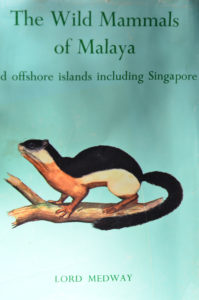 authoritative source of information on the mammals of Malaysia. Scanning through the tube-nosed bat descriptions, I found the closest match to be one with the common moniker of bronzed tube-nosed bat. It seemed pretty straight forward but, as I read the species description in Medway, I was startled. The text stated that not only was this bat known only from Malaysia, it was known from a single specimen taken in the neighboring state of Pahang. With rising pulse rate, I again ran through the measurements, observed the coloration, and referred to Medway’s description. I again came up with bronzed tube-nosed bat. Still not convinced that I hadn’t made an error in utilizing the taxonomic key, I ran through the characters a third time. Again the final couplet of the key led to Murina aenea, the bronzed tube-nosed bat.
authoritative source of information on the mammals of Malaysia. Scanning through the tube-nosed bat descriptions, I found the closest match to be one with the common moniker of bronzed tube-nosed bat. It seemed pretty straight forward but, as I read the species description in Medway, I was startled. The text stated that not only was this bat known only from Malaysia, it was known from a single specimen taken in the neighboring state of Pahang. With rising pulse rate, I again ran through the measurements, observed the coloration, and referred to Medway’s description. I again came up with bronzed tube-nosed bat. Still not convinced that I hadn’t made an error in utilizing the taxonomic key, I ran through the characters a third time. Again the final couplet of the key led to Murina aenea, the bronzed tube-nosed bat.
What a discovery! I sat staring in disbelief at the little mammal lying in my hand, an emissary from an alien world. Such a find would certainly be worthy of a note in the Malayan Nature Journal. Publishing such findings, even if they require no more than a one page communication, is the stuff of scientific fulfillment not to mention responsibility. But, I had to be sure of

the identification so I went to the ultimate source, the British biologist J.E. Hill. He was the mammalogist who had established the bat in question as a new species based upon the original specimen which had been collected by Medway himself. After receiving my introductory letter, describing what it was I thought I had found, Hill responded with a request to have the bat sent to him in England. After carefully protecting the specimens (skin and skull) in layers of cotton, I boxed the little bat and sent it on its way to the British Museum of Natural History in London. Correspondence by mail from one side of the earth to the other was not rapid in 1975. Finally, after a wait of nearly three weeks, a letter from Hill appeared in my mailbox. With excited anticipation, I opened the envelope. Yes! My identification was confirmed; I had indeed encountered only the second specimen of bronzed tube-nosed bat in the world. Hill also requested that the British Museum serve as the repository for the specimen. Building a museum collection at the University of Agriculture was important to me but it seemed only proper to have the second record housed in a more certifiably permanent site. I also felt that Hill held priority on the bat as both its discoverer and as a recognized expert of Southeast Asian bats. So, I responded with permission to retain the bat specimen.
Although it now lies, likely forgotten, in a drawer among the vast array of specimen cabinets within the British Museum, I recall this little mammal with something akin to affection. Through our chance meeting I was bestowed a wonderful reward. To be one of only a few people to have ever seen this mammal was an exceptional experience. I was granted the opportunity to sense, first hand, the thrill of scientific discovery. I was given the rare gift of the immortality bestowed by the written word. I felt the exhilaration of knowing that, for the fortunate explorer, extraordinary treasures still lie in wait within the rainforest. Yes, as I recall the little bronzed tube-nosed bat, I think affection is the correct word.
*psocid image courtesy of Tom Murray at https://bugguide.net/node/view/145918
Mammal images from Medway. 1969. The Wild Mammals of Malaya and offshore islands including Singapore. Oxford Univ. Press. London.
